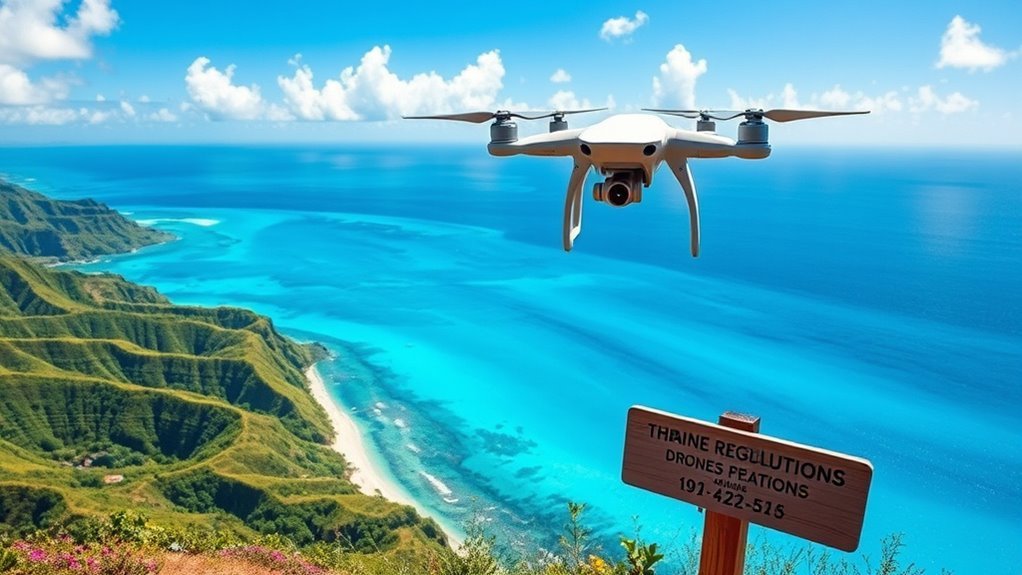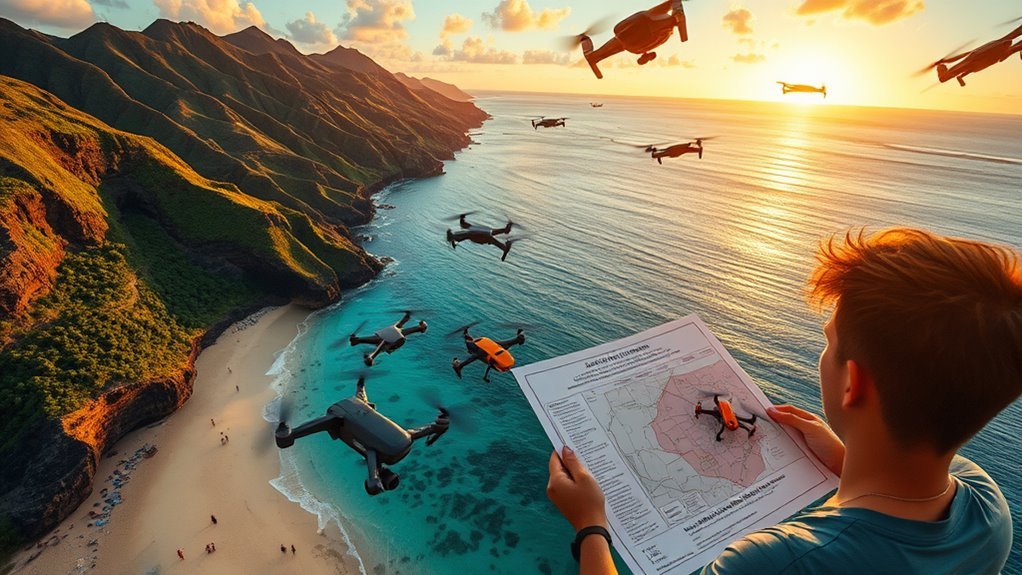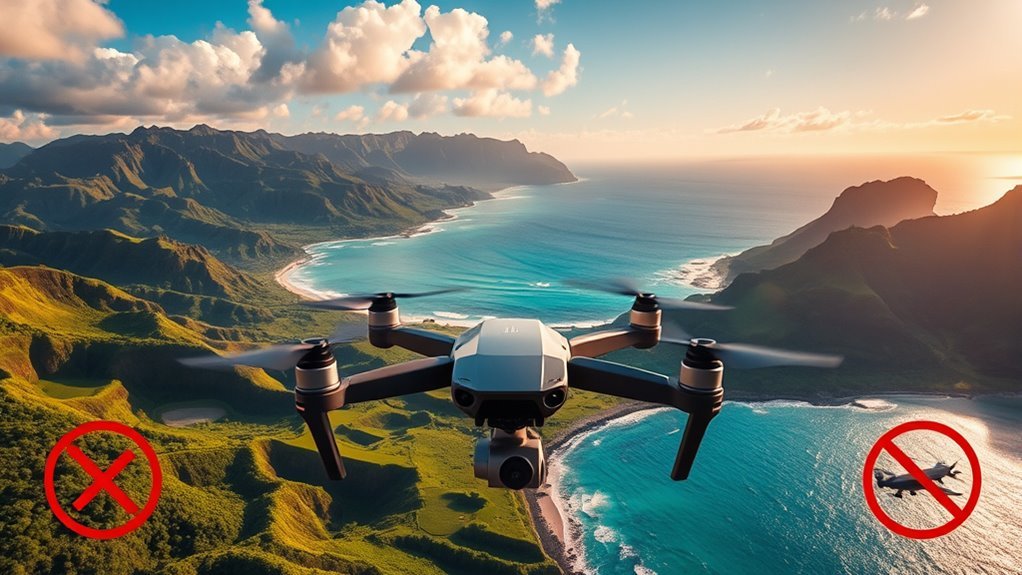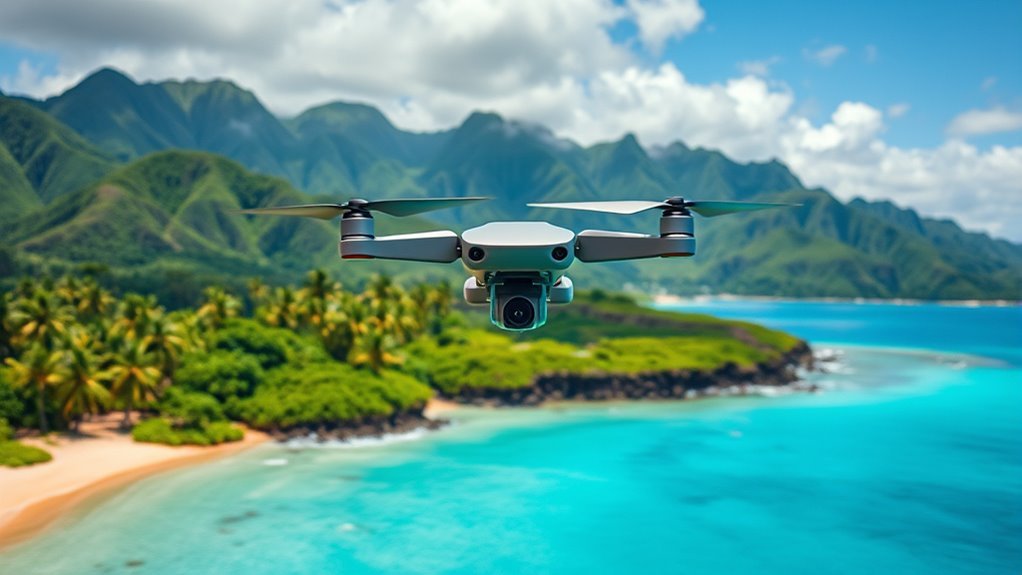In Hawaii, you can fly recreational drones under 55 pounds that follow FAA rules, and commercial drones must meet Part 107 standards with proper registration. You’ll need to register drones over 0.55 pounds and avoid restricted areas like national parks and military sites. Flying below 400 feet, keeping your drone in sight, and respecting privacy is essential. Staying informed about these requirements guarantees safe operation—explore further to understand all regulations and best practices fully.
Overview of Hawaii’s Drone Laws and Regulations

While drone technology continues to advance rapidly, Hawaii has established specific laws and regulations to secure safe and responsible drone use. You need to understand that the state’s drone enforcement policies are designed to protect privacy, uphold public safety, and preserve natural resources without unnecessarily restricting your freedom. Hawaii requires drone operators to comply with both federal FAA rules and additional state-specific requirements, such as restrictions on flying near certain landmarks and sensitive areas. Local drone communities actively engage with authorities to promote education and responsible flying practices, helping you stay informed and avoid penalties. By staying aware of these regulations, you can confidently enjoy your drone activities while respecting the unique environment and legal framework Hawaii enforces.
Types of Drones Permitted for Recreational and Commercial Use

Because Hawaii balances safety with innovation, it permits a range of drones for both recreational and commercial use, provided they meet specific criteria. When choosing your recreational drones, you’ll find models under 55 pounds that comply with FAA rules are generally allowed. For commercial drones, registration and adherence to Part 107 regulations are mandatory. Both types must respect flight altitude limits and operational guidelines to guarantee safety and privacy.
| Drone Type | Weight Limit | Key Requirements |
|---|---|---|
| Recreational | Under 55 lbs | Register if over 0.55 lbs, follow community guidelines |
| Commercial | Under 55 lbs | FAA Part 107 certification, registration, operational limits |
| Both Types | Varies | No night flights without waiver, maintain line of sight |
This framework lets you enjoy freedom while flying responsibly.
Restricted Areas and No-Fly Zones in Hawaii

Understanding the types of drones allowed is just one part of flying responsibly in Hawaii. You also need to be aware of restricted areas and no-fly zones that protect public safety and the environment. Hawaii has several designated airspaces where drone operations are strictly prohibited or limited. These include national parks, military installations, airports, and certain urban centers. Importantly, many zones are established to support wildlife protection, especially around nesting sites and habitats of endangered species. Flying your drone in these areas can cause serious harm and legal consequences. To maintain your freedom while respecting local regulations, always check current maps and notices before you launch. Staying informed guarantees you fly safely, responsibly, and legally within Hawaii’s unique airspace restrictions.
Registration and Certification Requirements for Drone Operators
Before you take to the skies in Hawaii, you’ll need to make certain your drone is properly registered and that you meet all certification requirements set by federal and state authorities. Drone registration is mandatory for drones weighing more than 0.55 pounds, ensuring accountability and safety.
Ensure your drone is registered and certified before flying in Hawaii for safe, legal skies.
To comply with regulations, follow these key steps:
- Register your drone through the FAA’s DroneZone portal to get a unique registration number.
- Obtain operator certification by passing the FAA’s Part 107 test if you plan on commercial flights.
- Carry proof of registration and certification whenever you fly, as authorities may request verification.
Meeting these requirements grants you the freedom to explore Hawaii’s skies responsibly and legally.
Best Practices for Safe and Responsible Drone Flying in Hawaii
Once you’ve secured the proper registration and certification, your focus should shift to adopting best practices that guarantee safe and responsible drone operation in Hawaii. Always respect drone etiquette by maintaining a safe distance from people, wildlife, and private property—this isn’t just courteous, it’s the law. Avoid flying near airports or restricted zones to prevent conflicts with manned aircraft. For aerial photography, choose clear weather and open spaces to maximize safety and image quality. Keep your drone within visual line of sight at all times, and never fly above 400 feet. Be mindful of local regulations and cultural sites, preserving Hawaii’s natural beauty and heritage. By following these guidelines, you confirm a rewarding drone experience while protecting the freedom to fly responsibly.

